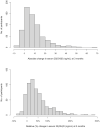The Relationship of Falls With Achieved 25-Hydroxyvitamin D Levels From Vitamin D Supplementation: The STURDY Trial
- PMID: 35592513
- PMCID: PMC9113179
- DOI: 10.1210/jendso/bvac065
The Relationship of Falls With Achieved 25-Hydroxyvitamin D Levels From Vitamin D Supplementation: The STURDY Trial
Abstract
Context: The Study to Understand Fall Reduction and Vitamin D in You (STURDY), a randomized trial enrolling older adults with low 25-hydroxyvitamin D [25(OH)D], demonstrated vitamin D supplementation ≥ 1000 IU/day did not prevent falls compared with 200 IU/day, with doses ≥ 2000 IU/day potentially showing safety concerns.
Objective: To examine associations of achieved and change in 25(OH)D concentrations after 3 months of vitamin D supplementation with fall risk.
Design: Observational analysis of trial data.
Setting: General community.
Participants: A total of 637 adults aged ≥ 70 with baseline 25(OH)D concentrations 10 to 29 ng/mL and elevated fall risk. Three-month on-treatment absolute 25(OH)D; absolute and relative changes from baseline.
Main outcome measures: Incident first fall (primary) and first consequential fall (injury or sought medical care) up to 24 months. Cox models were adjusted for sociodemographics, season, Short Physical Performance Battery, and body mass index.
Results: At baseline, mean (SD) age was 77.1 (5.4) years and 25(OH)D was 22.1 (5.1) ng/mL; 43.0% were women and 21.5% non-White. A total of 395 participants experienced ≥ 1 fall; 294 experienced ≥ 1 consequential fall. There was no association between absolute achieved 25(OH)D and incident first fall (30-39 vs < 30 ng/mL hazard ratio [HR], 0.93; 95% CI, 0.74-1.16; ≥40 vs < 30 ng/mL HR, 1.09; 95% CI, 0.82-1.46; adjusted overall P = 0.67), nor absolute or relative change in 25(OH)D. For incident consequential first fall, the HR (95% CI) comparing absolute 25(OH)D ≥ 40 vs < 30 ng/mL was 1.38 (0.99-1.90).
Conclusion: Achieved 25(OH)D concentration after supplementation was not associated with reduction in falls. Risk of consequential falls may be increased with achieved concentrations ≥ 40 ng/mL.
Trial registration: ClinicalTrials.gov: NCT02166333.
Keywords: 25-hydroxvitamin D; fall risk; vitamin D.
© The Author(s) 2022. Published by Oxford University Press on behalf of the Endocrine Society.
Figures


References
-
- National Council on Aging. https://www.ncoa.org/article/get-the-facts-on-falls-prevention. Accessed November 28, 2020.
Associated data
Grants and funding
LinkOut - more resources
Full Text Sources
Medical
